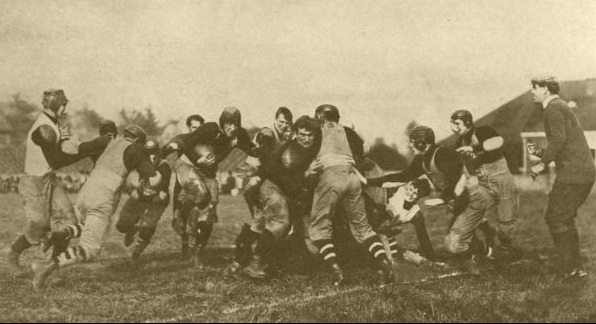Several teams from the league’s inception in 1920 have not survived to taste the financial and popular success that current multi-billion franchises have, however, which of those teams have left their mark on football the sport and the obsession?
If the 1920s was a decade that tested the wherewithall of football franchises, than there are not even a handful of teams that made it past square one. If the football team’s name was not the Cardinals, Bear or Packers, then it was likely one of several on this list, but teams in the first decade of the league were perhaps the biggest experiments in viability given their small town market, usually based in Ohio and Pennsylvania.
Several examples could be used, but here are five teams worth remembering. First off though, note that there are 49 football teams that did not survive the test of time.
Akron Pros: were a part of the Ohio League in 1908 as the Akron Indians. They finally hit the jackpot in a World Championship in the first year of the American Professional Football Association (NFL) In its early years they attracted Peggy Parrot from the Massilon Tigers to play for their slightly larger market team. Due to financial issues though in 1927 they through in the towel, and their franchise was sold.

Canton Bulldogs: a prominent franchise in the early 1900s, it was not only a successful team but an organization that was defamed by scandal in 1906, when Bulldog Coach and a few of his players were implicated in an attempt to throw a 2-game series with the Massilon Tigers. This in a day, when the competition was so fierce that successful teams paid what was considered big money in the day to recruit great players. Three-time Ohio League Champs and two-time NFL champs, the Bulldogs played in spurts from 1903-1906, 1911-1919, 1921-23 and 1925-26. But their city name lives on in NFL lore as the home of the Hall of Fame.

Columbus Panhandles: Not the most successful franchise in early football history, the Panhandles were run by Joseph Carr, the eventual first commissioner of the APFA (NFL). The team was known by its all-in-the-family players of repute the Nesser Brothers. Seven brothers who all worked the Pennsylvania railroad and played football. One brother Ted became a player coach and was joined by his son. The brothers were so good that they drew crowds from around the country. The team lasted from 1907 to 1926. The Panhandles’ rosters did not include many former college players, so the athletic field in the railroad yards was the place where the team found out who could play.[citation needed] The team’s “dirty” reputation[by whom?] was learned and developed on the railroad yards,

Duluth Eskimos: The northern most team in the NFL, it was forced to or had the honor of being a fulltime road team. The cold weather was not ideal for hosting football games in the fall, even for as short as the seasons were in those early days. In its early days it had only 3-6 games a season, but once they were renamed the Eskimos they became an all-road team, a kind of circus team, where they traveled by train all the northcentral and northeast, becoming a major attraction in every host city or town they visited.
Ernie Nevers, a college standout FB and baseball player, was recruited in 1926 — spurring a name change to the Ernie Nevers Duluth Eskimos. The traveling team idea was a success and the Eskimos finished in the middle of the league, but the following 1927 season was far less successful and player-coach Nevers soon left to play baseball and the team was sold. The team was the basis for the movie “Leatherheads.”

Pottsville Maroons: The Maroons played from 1925-1928. The following year they moved to Boston where they played one season as the Boston Bulldogs.
In their first season in the NFL they won the league Championship — which was determined by the number of games a team one overall vs a head-head matchup. In that year’s end the team played an additional game that was not permitted by league rules of playing a game in or close to another teams venue. This led to their disqualification and the selection of the Chicago Cardinals as default champs. Every season there after was not even close to being successful.
The 1928 team included famous ballplayers who both came from the Duluth Eskimos: Johnney “Blood” McNally and Walt Kiesling.

